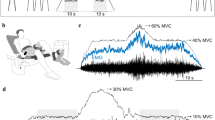Summary
The objective of the present study was to investigate the myo-electric signs of muscle fatigue and the isometric force tremor of two extrinsic hand muscles, extensor digitorum communis and flexor digitorum superficialis, during isometric power grip. In addition, the synergy between flexor and extensor muscles and hand differences in a right-handed population have been studied. During isometric hand-dynamometry the myo-electric signal was recorded using surface electrodes and isometric force tremor was recorded using a special load cell. Eight subjects participated in this study and contractions were performed at 20%, 40%, 60% and 80% of maximal voluntary contraction (MVC) with left and right hands. The decrease of mean power frequency (MPF) with duration of contraction was greater in the left extensor as compared to the ipsilateral flexor muscle. No differences in the decrease in MPF with the duration of the contraction were found between the right extensor and flexor muscles. Isometric force tremor root mean square did not change during contractions at a given contraction level. Isometric tremor amplitude increased from 20% to 60% MVC and decreased at higher contraction levels. Tremor amplitude was higher in the left hand at all contraction levels but 60% MVC. These data would suggest differences in fatiguability and muscle fibre composition between the dominant and nondominant hand, which may be due to preferred use. The significance of force tremor for the evaluation of recruitment order and muscle fatigue is discussed.
Similar content being viewed by others
References
Allum JHJ, Dietz V, Freund HJ (1976) Neuronal mechanisms underlying physiological tremor. J Neurophysiol 41: 557–571
Arendt-Nielsen L, Mills KR (1988) Muscle fiber conduction velocity, mean power frequency, mean EMG voltage and force during submaximal fatiguing contractions of human quadriceps. Eur J Appl Physiol 58: 20–25
Basmajian JV, DeLuca CJ (1985) Muscles Alive. Williams and Wilkins, Baltimore, Md.
Bigland-Richie B, Cafarelli EJ, Vollestad NK (1986) Fatigue of submaximal static contraction. Acta Physiol Scand 128 [Suppl 556]: 137–148
Borg K, Borg J, Edström L, Grimby L (1988) Effects of excessive use of remaining muscle fibers in prior polio and LV lesions. Muscle Nerve 11: 1219–1230
Brody LIZ, Pollock MT, Roy SH, DeLuca CJ, Celli B (1991) pH-induced effects on median frequency and conduction velocity of the myoelectric signal. J Appl Physiol 71: 1878–1885
Byström SEG, Kilbom A (1990) Physiological response in the forearm during and after isometric intermittent handgrip. Eur J Appl Physiol 60: 457–466
Christakos CN (1982) A study of the muscle force wave form using a population stochastic model of skeleton muscle. Biol Cybern 44:91–106
DeLuca CJ (1984) Myoelectrical manifestations of localized muscular fatigue in humans. CRC Crit Rev Biomed Eng 11:251–279
DeLuca CJ, Sabbahi A, Roy SH (1986) Median frequency of the myoelectric signal: effects of hand dominance. Eur J Appl Physiol 55:457–464
Eberstein A, Beattie B (1985) Simultaneous measurement of muscle conduction velocity and EMG power spectra changes during fatigue. Muscle Nerve 8:768–733
Furness P, Jesop J, Gottlieb OCJ (1977) Long-lasting increase in the tremor of human hand muscles following brief, strong effort. J Physiol 265:821–831
Gallasch E (1992) Mikrovibration und physiologischer Tremor an der oberen Extremitat des Menschen bei Schwerelosigkeit und im Schlaf. Thesis, Technical University, Graz
Gallasch E, Löscher WN (1992) Characterisation of isometric tremor in the hand. Proceedings of the 14th International Conference. Proc IEEE-BME 14:1632–1634
Garnet D, Maton B (1989) The fatigability of two agonistic muscles in human isometric submaximal contraction: an EMG study. Eur J Appl Physiol 58:361–368
Hoff AL (1991) Errors in frequency parameters of EMG power spectra. IEEE Trans Biomed Eng 38:1077–1088
Juel C (1986) Potassium and sodium shifts during in vitro isometric muscle contraction, and the time course of the ion gradient recovery. Eur J Physiol 406:458–463
Kleinbaum DG, Kupper LL (1978) Applied regression analysis and other multivariable methods. Duxbury Press, North Scituate, Mass., pp 104–105
Krogh-Lund C, Jorgensen K (1991) Changes in conduction velocity, median frequency, and root mean square-amplitude of the electromyogram during 25% maximal voluntary contraction of the triceps brachii muscle, to limit of endurance. Eur J Appl Physiol 63:60–69
Le Bozec S, Maton B, Cnockaret JC (1980) The synergy of elbow extensor muscles during static work in man. Eur J Appl Physiol 43:57–68
Lindström LH, Magnusson RI (1977) Interpretation of myoelectric power spectra: a model and its applications. Proc IEEE 65:653–622
Linssen WHIP, Stegman DF, Joosten EMG, Binkhorst RA, Merks MJH, Ter Laak HJ, Notermans SLH (1991) Fatigue in type I fiber predominance: a muscle force and surface EMG study on the relative role of type I and type II muscle fibers. Muscle Nerve 14:829–837
Maton B (1976) Motor unit differentiation and integrated surface EMG in voluntary isometric contraction. Eur J Appl Physiol 35:149–157
Stulen FB, DeLuca CJ (1978) The relationship between the myoelectric signal and physiological properties of constant-force isometric contractions. Electroencephalogr Clin Neurophysiol 45:681–698
Stulen FB, DeLuca CJ (1981) Frequency parameters of the myoelectric signal as a measure of muscle conduction velocity. IEEE Trans Biomed Eng 28:515–523
Tanaka M, McDonagh MJN, Davies CTM (1984) A comparison of the mechanical properties of the first dorsal interosseus in the dominant and non-dominant hand. Eur J Physiol 53:17–20
Zipp P (1982) Recommendations for standardization of lead position in surface electromyography. Eur J Appl Physiol 50:41–54
Author information
Authors and Affiliations
Rights and permissions
About this article
Cite this article
Löscher, W.N., Gallasch, E. Myo-electric signals from two extrinsic hand muscles and force tremor during isometric handgrip. Europ. J. Appl. Physiol. 67, 99–105 (1993). https://doi.org/10.1007/BF00376651
Accepted:
Issue Date:
DOI: https://doi.org/10.1007/BF00376651




